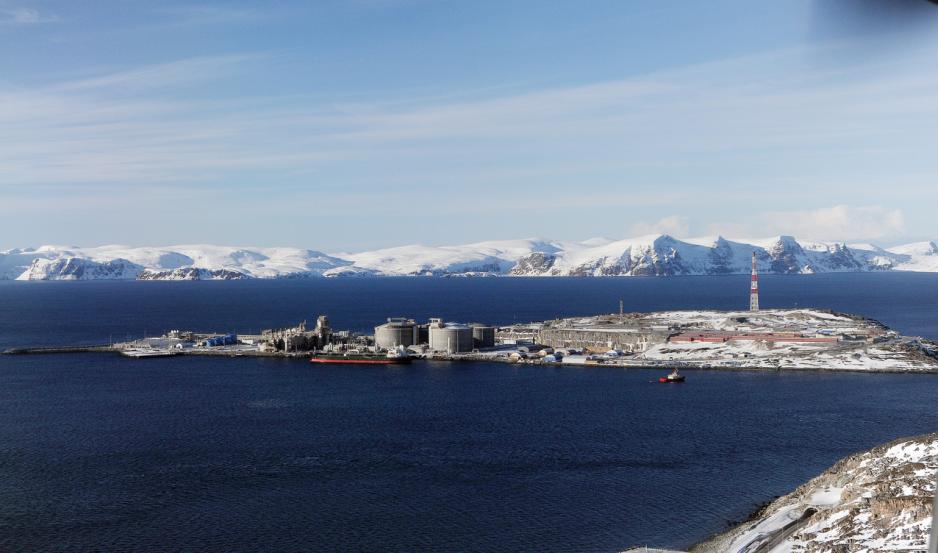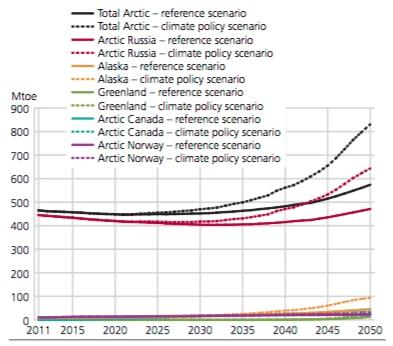Arctic gas production to increase due to climate policies

Accumulated Arctic gas production will increase with 12 per cent in the period of 2015-2050 as a result of the implementation of the Paris agreement, according to a new report by Statistics Norway (SSB).
The recently released report, The Economy of the North (ECONOR), givers a comprehensive overview of the economy of the circumpolar Arctic, including the future of the petroleum production in the region. The report finds that the implementation of the Paris agreement – reaching the goal to limit the global temperature rise to 2 degrees Celsius – could lead to an increase of gas production in the Arctic, mainly as a result of the phase-out of coal.
The report that was presented at SSB in Oslo on March 21 is a result of the ECONOR III project, carried out under the Sustainable Development Working Group (SDWG) in the Arctic Council, with Norway in the lead, but with contributions of other circumpolar nations.
Impossible to keep climate change and the economy seperate
"It’s impossible to keep climate change and the economy separate, and the Arctic economies are already affected by climate change," said Iulie Aslaksen, the ECONOR project leader and co-editor of the report during the presentation at SSB. The report looks at several ways climate change affects the northern economies, but the less obvious one is the possible effect of climate policies on arctic petroleum production.
Shifting demands in direction of gas consumption
According to one of the authors of the chapter on Arctic petroleum extraction under climate policies, Lars Lindholt, the regulations or taxes that will likely target the CO2 intensive fossil fuels (mainly coal) in the near future, will cause shifts in demand, leading to an increase in gas consumption. Gas is widely used in power generation where it can substitute for coal.
The Arctic region is estimated to hold up to 30 per cent of the world’s undiscovered natural gas.
The study in the ECONOR report uses a reference scenario towards 2050, assuming no new international climate agreement. It then compares this with a scenario with a climate policy sufficient to reach the 2 degree Celsius limit. The study applies the FRISBEE model of global petroleum markets, which is a recursive, dynamic partial equilibrium model for fossil fuels, renewables and electricity in 15 regions worldwide.
12 per cent increase in accumulated gas production
In the climate policy scenario, total Arctic gas production increases around 2025, reaching almost 860 Mtoe (Million Tonnes of Oil Equivalent) in 2050, more than 250 Mtoe above the level in the reference scenario with no climate policy. In the total Arctic, this leads to an increase in accumulated gas production of 12 per cent compared to the reference scenario over the period of 2015-2050.
| Total Arctic | Greenland | Russia | Canada | Alaska | Norway |
| 12 | 98 | 10 | 28 | 51 | 11 |
Increase in accumulated gas production 2015-2015. Climate policies scenario. Deviation from reference scenario. Per cent. Source: SSB

Undiscovered Russian resources
As we can see, the gas giant Russia will increase its production after 2025, and in total increase gas production by 10 per cent compared to the reference scenario in this time frame. According to the report, a big share of this increase will have to come from offshore resources that have not yet been discovered.
The Russian Arctic holds up to 70 per cent of the region’s undiscovered natural gas reserves. However, one could ask how realistic this scenario is, considering that there is currently no gas production in Russian Arctic waters. Offshore extraction is costly and requires new technological expertise.
According to the report, Alaskan gas production will also see a significant impact of climate policy, and production will reach over 100 per cent above the reference scenario by 2050. Such an increase in production will most likely require new gas pipelines to be built.
The Obama administration banned drilling in Arctic waters earlier this year, but a majority of the Alaskan undiscovered gas is found onshore on the North Slope.
No Arctic gas bonanza
The possible increase of gas production with climate policies will also lead to the Arctic gaining more importance as a gas region globally, but not significantly. According to the model, the Arctic will increase its share in production outside the Middle East slightly compared to the reference scenario, because the need to substitute gas for coal will gradually empty reserves in the Middle East.
But the Arctic will still only stand for 13 per cent of the world gas production in 2050, compared to a 17 per cent share in 2015.
